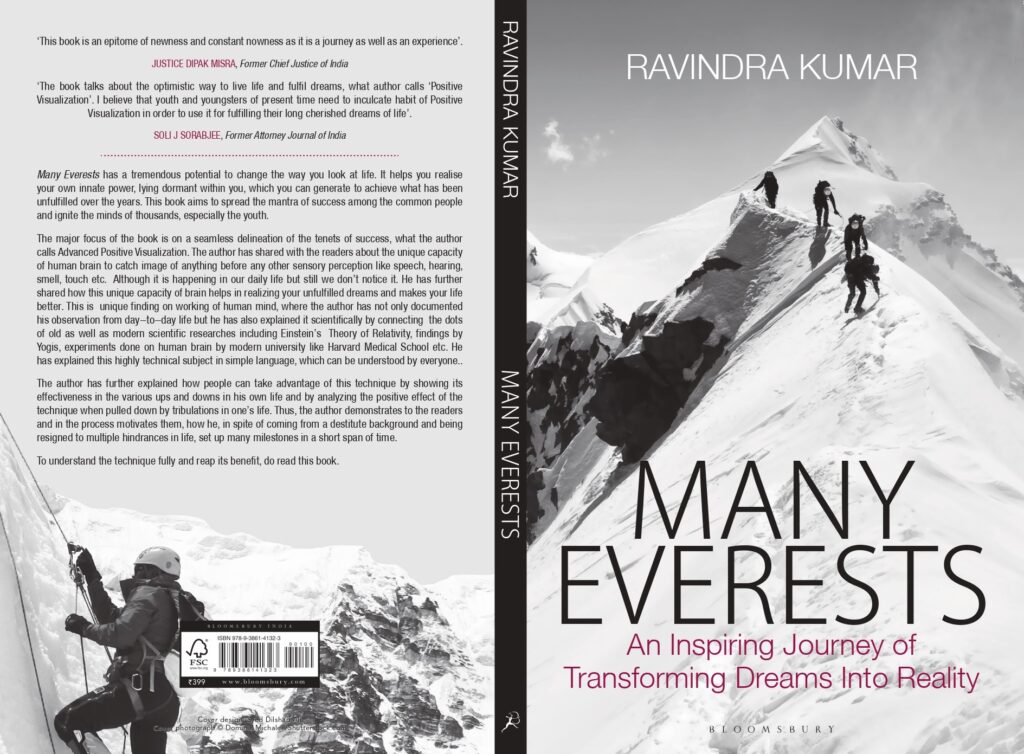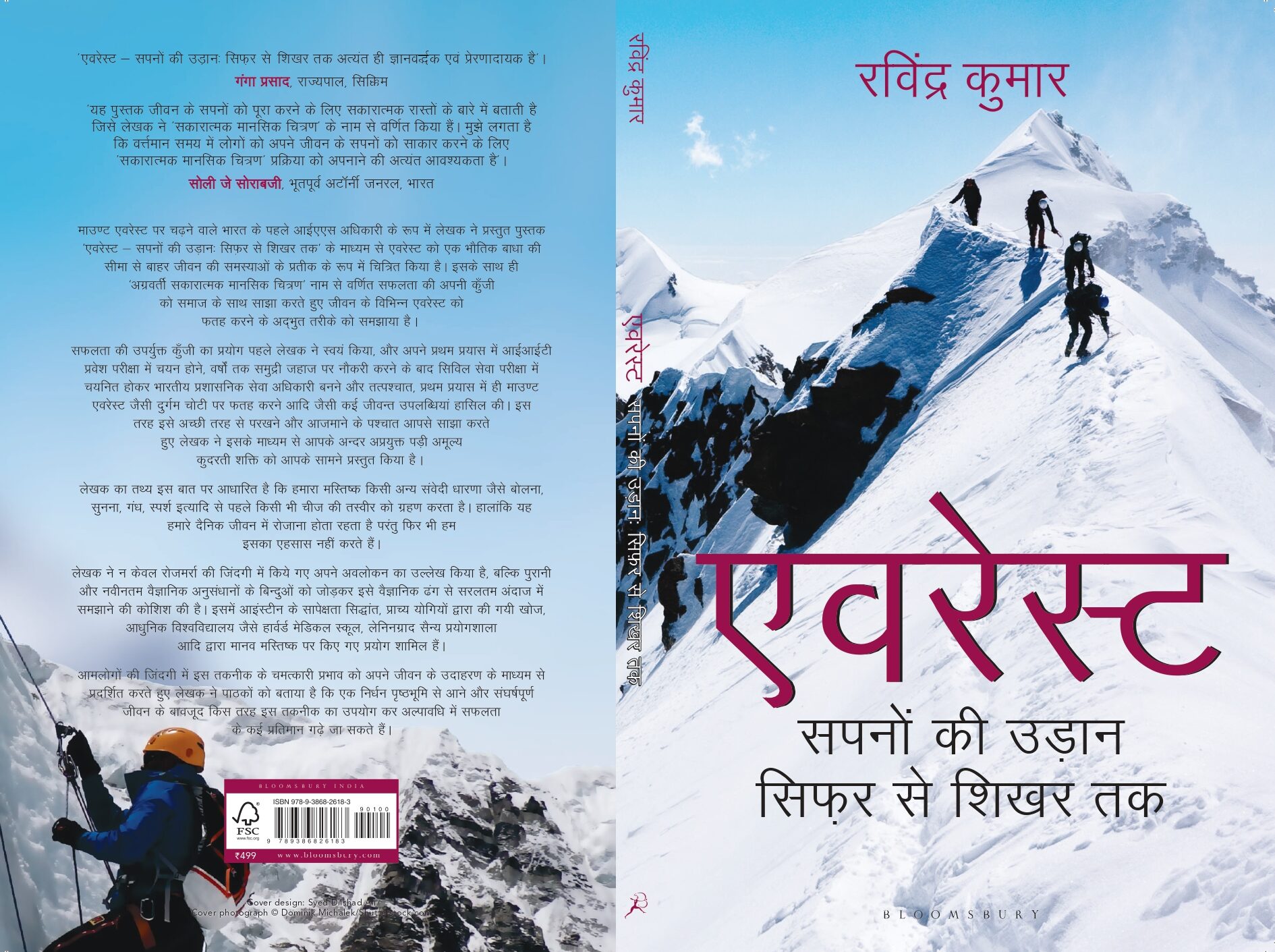With Hon'ble Ex-President of India Shri Ramnath Kovind Ji
With Hon'ble Ex-Vice President of India Shri Venkaiah Naidu Ji
With Hon'ble Union Home Minister, GOI Shri Amit Shah Ji

With Hon'ble Defense Minister, GOI Shri Rajnath Singh Ji

With Hon'ble Governor of Bihar Shri Arif Mohammad Khan Ji

With Hon'ble Chief Minister of Bihar Shri Nitish Kumar Ji

With Hon'ble Ex-Vice President of India Shri Jagdeep Dhangar Ji
With Hon'ble Prime Minister of India Shri Narendra Modi Ji

With Hon'ble Chief Minister of UP Shri Yogi Adityanath Ji
With Hon'ble Union Cabinet Minister, GOI Shri Gajendra Singh Shekhawat Ji

With Hon'ble Cabinet Minister, GOI Shri Sarbananda Sonowal Ji
With Bollywood Actor Shri Anupam Kher Ji
Book: “Many Everests”
An Inspiring Journey of Transforming Dreams into Reality
A powerful and insightful read on the functioning of the human mind and its effect of positive visualisation, drawn from the life experience of the first IAS officer to climb Mount Everest. As the first IAS officer to climb the world’s tallest peak, Ravindra Kumar in this book has presented Mount Everest as a symbol of life’s problems beyond the limit of a physical barrier. Introducing the innovative technique of ‘Advanced PositiveVisualisation’, the author explains how the various Everests of life can be conquered with this success key.

Kumar’s claim is based on the fact that our brain catches the image of anything before any other sensory perception like speech, hearing, smell, touch, etc. Although this is a daily phenomenon we don’t notice it. The author has not only documented his observation from day-to-day life but has also explained it scientifically by connecting the dots of old as well as modern scientific researches, including Einstein’s theory of relativity, findings by yogis, experiments on human brain by modern research centres such as Harvard Medical School, Leningrad Military Laboratory, etc. He hasexplained this technical subject in a simple lucid language to be understood by all.
By demonstrating the miraculous effect of this technique in the lives of ordinary people through the example of his life, the author explains to the readers, and in the process motivates them on how, despite life’s vicissitudes, one can achieve one’s dreams.
Book: “एवरेस्ट”
सपनों की उड़ान: सिफ़र से शिखर तक
माउण्ट एवरेस्ट पर चढ़ने वाले भारत के पहले आईएएस अधिकारी केरूप में लेखक ने प्रस्तुत पुस्तक ‘एवरेस्ट – सपनों की उड़ान: सिफ़र से शिखर तक’ के माध्यम से एवरेस्ट को एक भौतिक बाधा की सीमा सेबाहर जीवन की समस्याओं के प्रतीक के रूप में चित्रित किया है।इसके साथ ही ‘अग्रवर्ती सकारात्मक मानसिक चित्रण’ नाम से वर्णितसफलता की अपनी कुँजी को समाज के साथ साझा करते हुए जीवनके विभिन्न एवरेस्ट को फतह करने के अद्भुत तरीके को समझाया है ।

सफलता की उपर्युक्त कुँजी का प्रयोग पहले लेखक ने स्वयं किया, औरअपने प्रथम प्रयास में आईआईटी प्रवेश परीक्षा में चयन होने, वर्षों तकसमुद्री जहाज पर नौकरी करने के बाद सिविल सेवा परीक्षा में चयनितहोकर भारतीय प्रशासनिक सेवा अधिकारी बनने और तत्पश्चात, प्रथमप्रयास में ही माउण्ट एवरेस्ट जैसी दुर्गम चोटी पर फतह करने आदिजैसी कई जीवन्त उपलब्धियां हासिल की। इस तरह इसे अच्छी तरहसे परखने और आजमाने के पश्चात आपसे साझा करते हुए लेखक नेइसके माध्यम से आपके अन्दर अप्रयुक्त पड़ी अमूल्य कुदरती शक्तिको आपके सामने प्रस्तुत किया है लेखक का तथ्य इस बात पर आधारित है कि हमारा मस्तिष्क किसीअन्य संवेदी धारणा जैसे बोलना, सुनना, गंध, स्पर्श इत्यादि से पहलेकिसी भी चीज की तस्वीर को ग्रहण करता है। हालांकि यह हमारेदैनिक जीवन में रोजाना होता रहता है परंतु फिर भी हम इसकाएहसास नहीं करते हैं।
लेखक ने न केवल रोजमर्रा की जिंदगी में किये गए अपने अवलोकनका उल्लेख किया है, बल्कि पुरानी और नवीनतम वैज्ञानिकअनुसंधानों के बिन्दुओं को जोड़कर इसे वैज्ञानिक ढंग से सरलतमअंदाज में समझाने की कोशिश की है। इसमें आइंस्टीन के सापेक्षतासिद्धांत, प्राच्य योगियों द्वारा की गयी खोज, आधुनिक विश्वविद्यालयजैसे हार्वर्ड मेडिकल स्कूल, लेनिनग्राद सैन्य प्रयोगशाला आदि द्वारामानव मस्तिष्क पर किए गए प्रयोग शामिल हैं।
आमलोगों की जिंदगी में इस तकनीक के चमत्कारी प्रभाव को अपनेजीवन के उदाहरण के माध्यम से प्रदर्शित करते हुए लेखक ने पाठकोंको बताया है कि एक निर्धन पृष्ठभूमि से आने और संघर्षपूर्ण जीवनके बावजूद किस तरह इस तकनीक का उपयोग कर अल्पावधि मेंसफलता के कई प्रतिमान गढ़े जा सकते हैं।

Coffee Table Book: “Mount Everest”
Experience The Journey
This photographic travelogue depicts the Himalayan journey of an Indian Administrative Services (IAS) officer, Ravindra Kumar, including his summit of Mt Everest twice through two different routes. It transcends you to many fascinating locations of the Himalayas in Sikkim, Nepal, Ladakh and Tibet, travelled and explored by Kumar. Further, it provides glimpses of picturesque mountains and stunning landscapes along with the rich biodiversity and cultural vibrancy caught along the routes. Depicted through captivating images, accurate route maps and crisp descriptions laid out in a story-like manner, it transports you to places of ethereal beauty.
As a mountaineer, Kumar’s adventures have spanned over a decade, summiting Mt Everest twice, which is an immensely inspirational achievement. This carefully curated gem also showcases the meticulous planning that goes in while engaging in such a risky adventure. It guides aspiring mountaineers to visualise their climb, fathom the difficulties and mentally prepare themselves for the ascent, which demands extreme physical fitness and unfortunately also ends up claiming many lives every year.
Moreover, it provides laypersons with an easy option to divert, unwind, relax and heal their mind by flipping through the soothing and calming scenes of the Himalayas, beautifully laid out throughout this magnificently crafted coffee table book. A painstaking work of stunning photographs and fearless narration, Mount Everest will leave a deep therapeutic effect on the human mind and body.

रविन्द्र कुमार (आई. ए. एस.) 23 मई 2019
को माउन्ट एवरेस्ट के शिखर पर तिरंगा लहराते हुए

रविन्द्र कुमार (आई. ए. एस.) 23 मई 2019 को माउन्ट
एवरेस्ट के शिखर पर गंगा जल अर्पित कर गंगा सफाई
एवं जल संरक्षण हेतु अपील करते हुए

रविन्द्र कुमार (आई. ए. एस.) 23 मई 2019
को माउन्ट एवरेस्ट के शिखर से
'नमामि गंगे' के माध्यम से गंगा
सफ़ाई एवं जल संरक्षण हेतु अपील करते हुए

रविन्द्र कुमार (आई. ए. एस.) 23 मई 2019 को
माउन्ट एवरेस्ट के शिखर पर

रविन्द्र कुमार (आई. ए. एस. 2011 बैच)
23 मई 2019 को माउन्ट एवरेस्ट के शिखर पर

रविन्द्र कुमार (आई. ए. एस.) 23 मई 2019
को माउन्ट एवरेस्ट के शिखर से 'स्वच्छ भारत अभियान'
के माध्यम से 'खुला शौच मुक्ति' हेतु अपील करत हुए